Hal Spacejock History
The Hal Spacejock series has done pretty well for itself over the years, after eventually landing with a trade publisher. One title become a national bestseller, another made the shortlist for Australia's top spec fic awards (both the Aurealis and the Ditmar), and yet another went through three printings. However, it wasn't always sunshine and roses, and I've typed up this history to give you some idea of the frustration and heartbreak involved in writing an ongoing series ... and trying to get it published in the first place!
The start. In 1994 I was struggling to finish a complex piece of programming, and getting nowhere fast. I pushed aside the code, opened an empty file in my word processor, and typed the most outlandish, unbelievable title for a story I could think of:
The adventures of Hal Spacejock and his robotic sidekick, Clunk.
It was more a protest than a serious attempt to write anything - I was showing my brain what it was going to be working on if it didn't get its act together. Before I knew what was happening, my fingers typed the following:
Hal and Clunk were motoring towards the capital, Forgburg, in a rented General Motors Skylark. The aircar was racing along two or three meters above the ground, its Collision Avoider MkIII working overtime sliding the vehicle around pedestrians, buildings, parked aircars and oncoming traffic.
I reread that snippet, and all thoughts of writing code went out the window. (Ten years later, I'm thinking LOSE THE PAST TENSE!) Anyway, on I went:
The aircar slowed as it approached a giant neon-lit archway. "Welcome to ForgBurg" flashed on and off in twenty-three different shades of orange. "Playfield of the Galaxy" flashed another sign in nine shades of green. Clunk turned his head and fixed his photo-receptors on Hal. "Bet you ten credits we won't find a parking spot."
Over the next few weeks I knocked out lots more in a similar vein - some of it without any past tense at all. I'd written a number of short stories before, some for the fun of it, many of them during the course of my Bachelor of Arts degree at Curtin University. But I'd never attempted a novel, and now that I had 25,000 words or so I was keen to find out how much more I had to go to. Using the new-fangled internet thing, one of the first things I looked up was 'length of a novel'. The result came in eventually (this was a 2400 baud modem) - 80,000 to 100,000 words! That was it for me, I gave up on the novel writing and went back to the code.
Picking up the threads. By 1997 I'd been programming for years, but didn't have any formal qualifications to back up my experience. So I went back to Curtin Uni to do a Grad Dip in computing, a 3-year part-time course for 'people without computer experience'. In effect, it was like hunting goldfish with a machine gun - very basic stuff. I started getting bored, and before long I was dragging a laptop into the lectures - and I wasn't typing notes, whatever the lecturers thought. Hal Spacejock started to take shape.
Finishing the book. At the end of 1997 I heard about a competition for unpublished Australian SF novels - The George Turner Prize. The winner would get $10,000 cash, but more importantly they would be published by Random House. Unfortunately, my novel was only half done and the competition was closing mid-January. In fact, Hal was still only 1/2 done when I finished my Grad Dip in 1999, and it was then I discovered that the George Turner Prize was an annual event. I got hold of an entry form in September 1999, which gave me 3 months to finish off the book and send it in. With about 40,000 words completed, I did what any sane, intelligent person would do and threw out everything but chapter one. I sent in my 80,000-word novel, barely meeting the deadline, and got a call two weeks later telling me I was on the shortlist for the final award. Didn't hear anything until May, when they phoned me on the 'announcement date' to say they were extending the judging deadline for a couple of weeks. Apparently, it was that close. Anyway, two weeks later they phoned to say that I hadn't won, but that the eight short-listed books would all be evaluated for publication. A few weeks after that, they wrote to say they didn't want Hal.
Looking for a printer. Mid-late 2000, I sent Hal to a publisher in the UK and another in the US, and after several months had no real interest from either. I decided it would take years for Hal to see print following that route, and started investigating self-publishing instead. (
Note: Although I self published several Spacejock books, they bear little resemblance to the versions now published by
FACP and distributed by Penguin. These new editions were almost completely rewritten. However, I'm documenting the history of Hal and intend to cover everything.)
Around that time Andromeda Spaceways published some of my fiction, and the great feedback I got plus the Aurealis Award I won for a short story in 2001 was enough to convince me to go ahead and publish my own novel.
DIY. Getting someone else to print my books was going to cost a fortune, and I would have ended up with thousands of the things. I thought it would be pretty neat to sell a hundred all up, so I decided to do it all myself. Yes, I set up my own publishing company, even registering the business name 'Bowman Publishing'. I bought an industrial strength laser printer with a duplexing attachment, came up with a cover (the green one, see section below) and printed a whopping 20 copies. I sent these to newspapers, bookshops and reviewers, trying to get some interest happening.
One of the biggest problems with self-published work is selling the things after you've printed them. Bookshops prefer to deal with a handful of major suppliers, rather than paying piddly little invoices from dozens of budding authors. And there's no quality control with self-published works - you could print the word 'inconceivable' 75,000 times in succession, slap a cover on it and call it a novel. (And spell it wrong to boot). Bookshops rely on editors and publishing houses not to print crap, which enables them to put books on the shelf without having to vet them first. If the person recommending the book also wrote it... who's to say it's any good?
Nevertheless, I ended up with a handful of orders from several specialist SF bookstores, and also from a couple of Dymocks stores. None of the orders amounted to much until Dymocks Carousel weighed in. Stefen Brazulaitis was so taken with Hal that he ordered a dozen copies (the one with the geometric cover, see below), and when I met him at Swancon I promised him the exclusive on Hal #2 when it came out. This was news to me, since I hadn't thought of writing another book in the series until then.
(Read the next part here)
Assorted Hal Spacejock covers, from old to new.
There were 20 copies with the green cover
(I drew this one myself. It was supposed to be a rough guideline to show a real artist, but when I contacted the artist I had in mind his agent quoted me $12,000.)
|
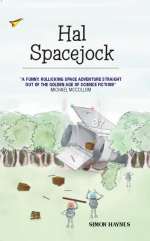
|
The dark blue cover with a new title. The image was drawn by my father-in-law. Originally I was going to use it as an internal illustration, but never did. There's only one copy of this edition, and I've got it.
|
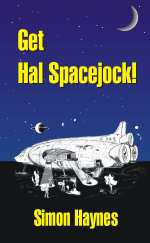
|
There were about 50 of these with the tin-opener cover
(Bit of a play on one of the Hitchhiker's Guide books, which had a ringpull):
|
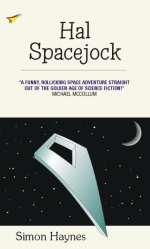
|
The geometric shapes cover (About 40 of these were given away to people who ordered a subscription to Andromeda Spaceways, back in 2001):
|
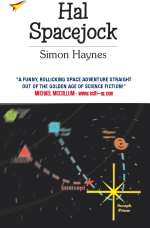
|
Clunk on the cylinder (I produced this one, then morphed it into the next one below):
|
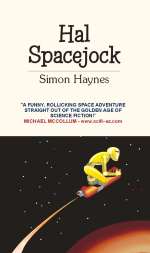
|
This cover had 'Hal Spacejock' in raised foil printing. I gave away a few of these to WA libraries, and sold a handful through bookstores. Even now I still use the covers for scrap card ... When it comes to self-publishing, think of a number and divide it by 100.
|
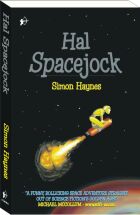
|
The last of the Bowman Publishing editions. Les Petersen's awesome work put a huge smile on my face when I first saw it. Sure, the robot in this picture is a towering muscle-man where Clunk is more of a weedy droid, but the expressions, the interplay, the massively outsized weapon - this WAS Hal and Clunk! (And it didn't cost me twelve grand either.)
|
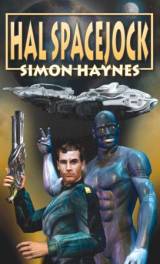
|
The first FACP edition. Les Petersen modified his artwork at the publisher's request, changing the background and giving Hal a completely new face. (2005)
|
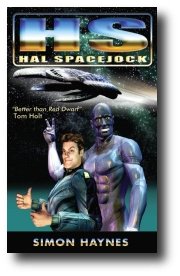
|
The second FACP edition. Dion Hamill was commissioned to do a Hal Spacejock cover to match books two and three. Hal's busted gun and Clunk's clipboard encapsulate the characters nicely. (2007)
|
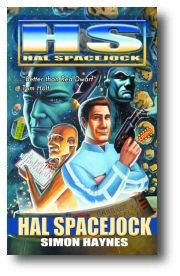
|
Second printing. Same image, different lettering, different back cover. (2008)
|

|
Third edition, released in various ebook formats by Bowman Press. This was a temporary cover while the new artwork was being commissioned. (Sept 2011)
|
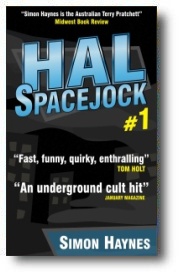
|
A slightly snazzier version of the temporary cover. (Oct 2011)
|
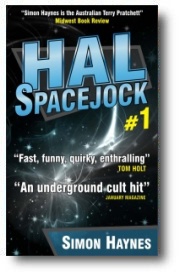
|
This one is from the new Bowman Press paperback edition
|
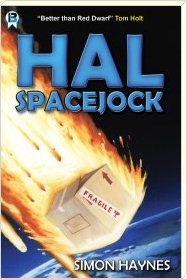
|
This one was used for the ebook in September 2012, just to test the impact on downloads.
|
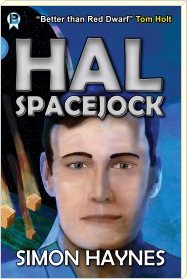
|
The cover above slowly morphed into this one:
|
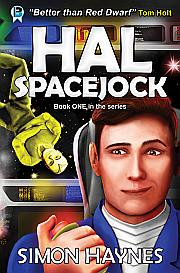
|
There were several covers made with stock images, from robots to spaceships and combinations of both. But this is the current cover (and it's still changing frequently!)
|
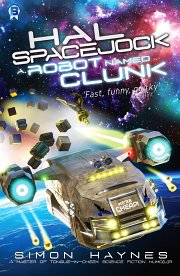
|
(Read the next part here)
Stay in touch!
Follow me on
Facebook or Twitter















